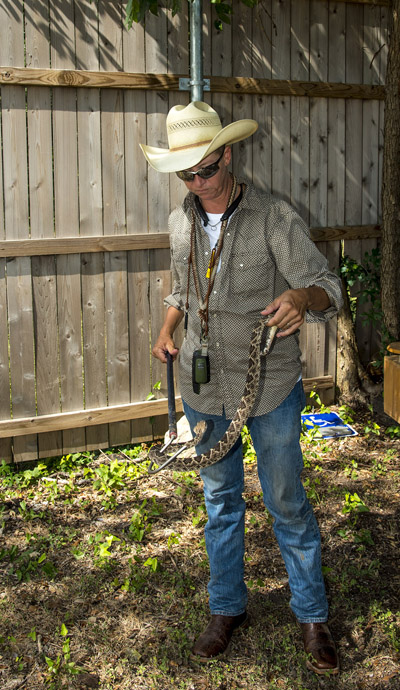by John Jefferson

All pet owners have either known the deep pain of losing a pet, or will sometime in the future.
I understand that sentence is a doleful way to start a column. I apologize. But it’s true that they’ll all pass. Every living thing does. Maybe you saw the installment of “Yellowstone” when Kevin Costner’s character’s grandson had just shot his first deer and Costner explained death to him. It was moving.
All pet deaths hurt. I’ll admit to still grieving over the tragic loss of my deer dog in the prime of his life. Death comes in many ways, but some may be avoidable. One of those is snakebite.
Texas has four poisonous snakes – rattlesnakes, copperheads, cottonmouth water moccasins, and coral snakes. Coral snake bites are rare. The others happen with unwanted regularity. Although rattlesnakes often sound a warning, they don’t always rattle, which makes it easy for someone or his dog to surprise the reptile in its realm. And that often leads to a snakebite.
My outrageous friend, Horace Gore, was turkey hunting one morning and stopped to listen for gobbling. He thought he felt something on his boot but was preoccupied. He felt it a couple more times and looked down. A small rattlesnake had just completed its third strike at his boot. It had never rattled.
Copperheads are camouflaged and often hidden in leaves or pine needles. Western diamondback rattlesnakes and other species of rattlers cause the most snakebites and the potency of their venom is about twice as severe as that from copperheads.
Cottonmouths are a little more potent and coral snakes and Mojave rattlesnakes are the most deadly in Texas, according to Alan Tennant’s “Field Guide to Texas Snakes.”
The best advice is to stay on open paths and avoid clumps of rock, cactus, or brush – especially in the dark. Charlie Pride even sang about that.
Many dogs are bitten when they curiously investigate too closely. Getting a snake-bitten dog to a vet quickly is the best medicine, although antivenin is expensive, if even available. Often, time and distance work against you.
Snake avoidance treatment helps preventing snakebite before it happens. We’ve put five dogs through the process for all three most likely snakes. It’s not available for coral snakes. And with all our adventures throughout the Texas outback, we’ve never had one bitten. Is it guaranteed? No. But it greatly reduces the possibility.
The way it usually works, a dog is fitted with an electric training collar and led near an experienced handler with a snake on the ground. The snake either has its venom sacks removed or its mouth stapled shut. As the dog draws close enough, the reptile usually strikes, and the handler simultaneously activates the electric collar. The dog usually jumps away. And seldom forgets the sight, smell, and sound (if it’s a rattlesnake) of the reptile AND the jolt associated with it.
We use Winter Kennels in Austin and Burnet. They charge $60/snake – a small price for peace of mind.
JJ




